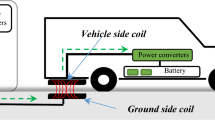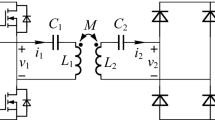Abstract
Wireless power transfer (WPT) systems typically consist of multiple cascaded power converters with their own operating modes. This paper proposes a cascaded modeling method, which segments the complex structure of the whole system into a number of power converter units (PCUs). For each PCU, a state-space model is constructed with the preceding PCU’s output voltage as its input voltage, and the succeeding PCU’s input impedance as its equivalent load. A regressive algorithm is developed to evaluate the full dynamic responses of the whole system using these PCU models. To illustrate the effectiveness of the proposed cascaded modeling method, a buck converter with a series connected inverter of a two-PCU WPT system is analyzed as an example. Both simulation and experiment results are used to verify the proposed modeling method. The proposed method significantly simplifies the modeling process of cascaded power electronic systems and achieves excellent accuracy for analyzing the nonlinear bifurcation behaviors.













Similar content being viewed by others
References
Hui SYR, Zhong W, Lee CK (2014) A critical review of recent progress in mid-range wireless power transfer. IEEE Trans Power Electron 29(9):4500–4511
Iguchi S, Yeon P, Fuketa H, Ishida K, Sakurai T, Takamiya M (2015) Wireless power transfer with zero-phase-difference capacitance control. IEEE Trans Circuits Syst I Regular Papers 62(4):938–947
Weearsinghe S, Thrimawithana DJ, Madawala UK (2015) Modeling bidirectional contactless grid interfaces with a soft dc-link. IEEE Trans Power Electron 30(7):3528–3541
Hui SY (2013) Planar wireless charging technology for portable electronic products and Qi. Proc IEEE 101(6):1290–1301
Wang Z, Li Y, Sun Y, Tang C, Lv X (2013) Load detection model of voltage-fed inductive power transfer system. IEEE Trans Power Electron 28(11):5233–5242
Wang B, Hu AP, Budgett D (2014) Maintaining middle zero voltage switching operation of parallel-parallel tuned wireless power transfer system under bifurcation. IET Power Electron 7(1):78–84
Cha H, Park W, Je M (2012) ”A CMOS rectifier with a cross-coupled atched comparator for wireless power transfer in biomedical applications. IEEE Trans Circuits Syst II: Express Briefs 59(7):409–413
Tang C, Sun Y, Su Y, Nguang SK, Hu A (2009) Determining multiple steady-state ZCS operating points of a switch-mode contactless power transfer system. IEEE Trans Power Electron 24:416–425
Miller JM, Onar OC, Chinthavali M (2015) Primary-side power flow control of wireless power transfer for electric vehicle charging. IEEE J Emerg Select Topics Power Electron 3(1):147–162
Madawala UK, Neath M, Thrimawithana DJ (2013) A power frequency controller for bidirectional inductive power transfer systems. IEEE Trans Ind Electron 60:310–317
Huang R, Zhang B (2015) Frequency, impedance characteristics and HF converters of two-coil and four-coil wireless power transfer. IEEE J Emerg Select Topics Power Electron 3(1):177–183
Wang C, Covic GA, Stielau OH (2004) Power transfer capability and bifurcation phenomena of loosely coupled inductive power transfer systems. IEEE Trans Ind Electron 51(1):148–157
Tang C, Sun Y, Dai X, Su Y and Wang Z (2010) Extended stroboscopic mapping (ESM) method: a soft-switching operating points determining approach of resonant inverters. In 2010 IEEE International Conference on Sustainable Energy Technologies (ICSET), Kandy, Sri Lanka, pp. 1–5.
Cheng KWE, Liu M, Wu J (2003) Chaos study and parameter-space analysis of the DC-DC buck-boost converter. IEEE Proceed Electric Power Appl 150:126
Hamill DC, Deane JHB, Jefferies DJ (1992) Modeling of chaotic DC-DC converters by iterated nonlinear mappings. IEEE Trans Power Electron 7:25–36
Phillips CL, Harbor RD (1996) Feedback control systems. Prentice Hall, Englewood Cliffs, New Jersey
Alexander C and Sadiku M (2000) Fundamentals of electric circuits. Mc-Graw -Hill Inc.
Sanders SR, Noworolski JM, Liu XZ, Verghese GC (1991) Generalized averaging method for power conversion circuits. IEEE Trans Power Electron 6:251–259
Middlebrook R and UK S (1976) A general unified approach to modelling switching-converter power stages. In IEEE Power Electronics Specialists Conference, pp. 1834.
Debbt MB, EI-Aroudi A, Giral R, Marti X and Nez-Salamero L (2002) Stability analysis and bifurcation of SEPIC DC-DC converter using a discrete-time model. In 2002 IEEE International Conference on Industrial Technology (ICIT), vol. 2, pp. 1055–1060.
Chan WCY and Tse CK (1996) Bifurcation in bifurcation from a current-programmed DC/DC boost converter. In 1996 IEEE International Symposium on Circuits and Systems (ISCAS), Atlanta, GA, 1996, vol. 3, pp. 249-252.
Wang X, Zhang B and Qiu D (2008) Bifurcations and chaos in H-bridge DC chopper under peak-current control. In 2008 International Conference on Electrical Machines and Systems(ICEMS), Wuhan, China, pp.2173–2177.
Funding
This work was supported in part by the National Natural Science Foundation of China under Grant 52,007,012, 51,977,178, in part by the Fundamental Research Funds for the Central Universities under Grant 2020CDJYGZDH005.
Author information
Authors and Affiliations
Corresponding author
Additional information
Publisher's Note
Springer Nature remains neutral with regard to jurisdictional claims in published maps and institutional affiliations.
Rights and permissions
About this article
Cite this article
Li, Y., Li, X. & Dai, X. Nonlinear behavior of wireless power transfer systems: modeling, analysis, and experimental verification. Electr Eng 104, 1219–1227 (2022). https://doi.org/10.1007/s00202-021-01379-2
Received:
Accepted:
Published:
Issue Date:
DOI: https://doi.org/10.1007/s00202-021-01379-2




